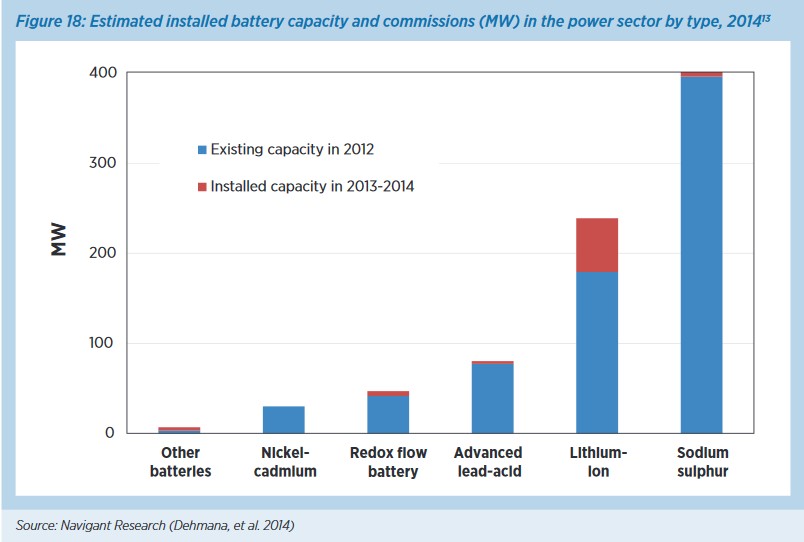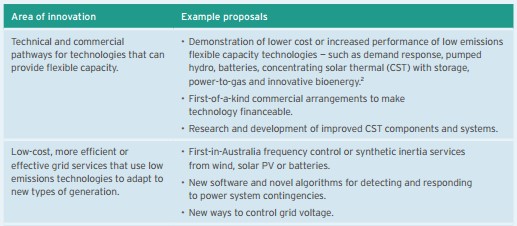Taking store of energy backup
Federal and State governments have set their sights on grid level energy storage to address system reliability and smooth the integration of intermittent renewables.
South Australia’s recently released state energy plan to address its reliability issues included a proposal to build ‘Australia’s largest battery’[i], while across the border the Victorian Government announced earlier in the year its ambition to build ‘Australia’s largest battery’.[ii] Meanwhile, Tasmania is already advanced in trialling storage systems as part of its King Island Renewable Integration Project (KIREIP) and for years pumped hydro storage has been in place at three sites in Australia. The Federal Government (championed by the Prime Minister Malcolm Turnbull) has advocated the introduction of more pumped hydro storage to assist the integration of renewables in the National Electricity Market (NEM) and declared, “We are making energy storage infrastructure a critical priority to ensure better integration of wind and solar into the energy market and more efficient use of conventional power” [iii].
The Federal Government is looking at the feasibility of up to 2000 MW of pumped storage. In South Australia, the Premier, Jay Weatherill, said the state was targeting its battery to be at least 100 MW. The tender process was initiated after the announcement. The Premier noted that there need not be one winner and flagged that that three different companies could provide 50 MW each. Victoria has proposed two 20 MW batteries to provide up to 100 MWh of power. Merit criteria and guidelines for applicants were available on 1 May[iv].
The store of options
So what different types of storage are out there and what are their characteristics?
When assessing storage options there are a number of considerations, including:
- Capacity
- Cost
- Size
- Safety
- Charge cycle
- Weight and number of charges in the life cycle (in the case of batteries)
Both pumped hydro and lead acid batteries have been around a long time. Lead acid batteries emerged in the middle of the 19th century. There are several different cell types that are classed as lead acid batteries – gel cell, absorbent glass mat and wet cells, which are considered to be the oldest type of rechargeable battery.
The Energy Storage Association places storage into six different categories:
- Solid state batteries – these include electrochemical storage systems such as lithium-ion, nickel-cadmium and sodium sulphur batteries. Hydro Tasmania has installed an electrochemical battery system, capable of 3 MW of power contribution and storing 1.6 MWh of useable energy as part of its King Island Renewable Integration Project (KIREIP). This battery is said to be the largest installed in Australia to date and can power the island for 45 minutes[v]. Lithium-ion batteries in particular have had the most impact on changing the dynamics of home and grid energy storage. The shift towards lithium ion batteries can be seen ramping up in 2013-2014 in Figure 1 below. This shift is due to the ability of lithium-ion batteries to go through deep discharge cycles, their energy and power density and their lower cost.[vi]
- Flow batteries - these include Redox Flow, Iron-Chromium Flow, Vanadium Redox Flow (VRB) and Zinc Bromine Flow batteries. Hydro Tasmania had installed a VRB in 2003 as part of its King Island Renewable Energy Expansion. Hydro Tasmania notes that, “The system was leading edge technology at the time but proved to be not robust enough and failed after a relatively short life. Investigation into restoring the VRB concluded it was not economically viable to restore and was decommissioned as part of the KIREIP project”. More promisingly, Zinc Bromine flow battery company Redflow recently announced an $800,000 deal to supply its batteries across the Pacific islands[vii].
- Flywheel – mechanical systems that harness rotational energy. A flywheel is being employed as part of KIREIP. It uses what is known as uninterruptible power supply class diesel engines (D-UPS) which contain a large mass flywheel. This uses excess wind energy rather than diesel power to maintain its motion, with the diesel engine only operates when the unit is needed to provide power for an extended period. The D-UPS is proven technology but its use in a remote power system of the size on King Island is considered a world-first[viii].
- Compressed Air Energy Storage - these are similar in principle to pumped-hydro power plants in terms of their applications, output and storage capacity. Instead of pumping water from a lower to an upper storage, ambient air is compressed and stored under pressure in an underground cavern.
- Thermal storage – is the capturing of heat and cold to create energy on demand. Solar thermal plants use this system by storing excess energy via molten salt or other materials. Heat pumps are another example.
- Pumped Hydro-Power – this has been in use for the better part of the last century. Water is pumped into a storage pool when electricity demand is low and then released to drive a turbine when demand is higher.
Aside from these there are groups also seeking to develop hydrogen fuel cells. Figure 1 below shows the installed capacity of different battery types in the power sector:
Figure 1: Estimated installed battery capacity and commissions (MW) in the power sector by type, 2014

Source: Navigant Research, 2014
Looking more closely at the storage situation in Australia, there are currently three pumped hydro power plants in Australia – CS Energy’s Wivenhoe Power plant in Queensland, Origin’s Shoalhaven plant and Snowy Hydro’s Tumut 3, both in New South Wales. Tumut 3 was the first pumped hydro plant in Australia.
Snowy Hydro is working with the Australian Renewable Energy Agency (ARENA) on a feasibility study into several sites that could support new large-scale storage, which has the support of the Federal Government[ix]. Snowy Mountains Engineering Corporation Australia (SMEC) has been appointed as the lead consultant engineer for the feasibility study. This work will first consider existing proposals, many of which of existed since the 1960s[x]. In Tasmania, there are plans to assess several pumped hydro schemes with a total of 2500 MW of storage capacity[xi]. There is also work underway by an Energy Australia - led consortium to investigate a 100 MW pumped hydro project in South Australia that would use seawater from the Spencer Gulf[xii]. Backed by a $450,000 grant from the ARENA, the ANU is mapping hundreds of potential short-term off-river pumped hydro energy storage (STORES) sites along the east coast from North Queensland to South Australia and Tasmania. In Queensland, Genex power is developing pumped hydro in an abandoned mine in conjunction with a large scale solar project.
Who is bidding to build the SA battery?
South Australia’s $150 million Renewable Technology Fund has reportedly attracted 20 syndicates[xiii]. Three days before the plan was even announced, Tesla CEO, Elon Musk made public his promise that he could fix the state’s energy crisis by installing 100 MW of battery storage in 100 days or it would be free.[xiv] Other firms known to be vying for the contract are:
- Carnegie Clean Energy
- Lyon Group
- Allied Nano Technologies
- ZEN energy
Interestingly, South Australian company 1414 Degrees (named for the melting point of silicone) is working on ramping up a trial 250 kW heat exchanger silicone battery to a grid level application, but submitted only a non-conforming bid to the SA Government.[xv] This form of battery takes advantage of the thermal storage potential of silicone. It is similar technology to molten salt in solar thermal plants.
Storage is also attracting greater focus from ARENA in its latest investment plan. Under its objective of delivering secure and reliable electricity ARENA has nominated energy storage as one of the things it is looking for. The following table shows some examples of what it is considering to develop flexible capacity and grid stability:
Table 1: Flexible capacity and grid stability

Source: Innovating Energy ARENA’s Investment Plan, May 2017
Funding rounds are expected to be announced on ARENA’s website in June.
A grand vision
Tesla is one of the most prominent of potential battery suppliers, thanks in large part to its effective marketing as well as its development of a “Gigafactory” to manufacture batteries. Telsa CEO, Elon Musk has grand visions for how battery technology will change the world. At the launch of the Powerwall and Powerpack in 2015, Musk claimed that $160 million Powerpacks would be enough to transition the United States to sustainable energy. The American think tank, the Breakthrough Institute disputes these numbers, pointing out that this 16 terawatt hours of storage would only be able to back up the grid for 34 hours based on average demand. Heatwave or cold snap conditions would reduce this time.[xvi]
In the case of the South Australian battery plan, presumably Tesla would be planning to install a series of their Powerpack batteries, which is their product for business and utility scale storage. Each of these Powerpacks has a storage capacity of 50 kW/210 kWh. If the entire 100 MW bid was fulfilled with these batteries, it would mean 2000 would be needed. Tesla batteries use lithium ion chemistry.
What will it cost?
While battery costs have been falling, the further development of large-scale storage will be dependent on it being cost competitive and efficient. The current projects and proposals will be important in that context.
[i] http://ourenergyplan.sa.gov.au/
[ii] https://284532a540b00726ab7e-ff7c063c60e1f1cafc9413f00ac5293c.ssl.cf4.rackcdn.com/wp-content/uploads/2017/02/170217-Australias-Largest-Battery-To-Be-Built-In-Victoria.pdf
[iii] Prime Minister’s media release, “Securing Australia’s energy future with Snowy Mountains 2.0”, 16 March 2017
[iv] http://www.premier.vic.gov.au/storage-to-strengthen-victorias-energy-system/
[v] http://www.kingislandrenewableenergy.com.au/project-information/energy-storage-system
[vi] http://www.irena.org/DocumentDownloads/Publications/IRENA_Battery_Storage_report_2015.pdf
[vii] http://redflow.com/6736/
[viii] http://www.kingislandrenewableenergy.com.au/project-information/diesel-ups
[ix] Snowy Hydro media release “Expanding pumped hydro storage”, 15 March 2017
[x] http://www.snowyhydro.com.au/news/snowy-hydro-and-smec-reunite-for-snowy-2-0/
[xi] Prime Minister’s media release, “New Tasmanian Pumped Hydro”, 20 April 2017
[xii] EnergyAustralia media release “Consortium assessing pumped hydro storage plant in South Australia, 21 February 2017
[xiii] http://www.afr.com/business/energy/sa-battery-bid-carnegie-samsung-join-the-race-20170330-gvahot
[xiv] http://www.abc.net.au/news/2017-03-10/tesla-boss-elon-musk-pledges-to-fix-sas-electricity-woes/8344084
[xv] http://www.adelaidenow.com.au/business/jobs/silicon-storage-better-than-batteries-and-cheaper-says-adelaide-company-1414-degrees/news-story/5fea2f741d90de4932f32f8de230ad77
[xvi] https://thebreakthrough.org/index.php/issues/renewables/the-grid-will-not-be-disrupted
Related Analysis
Certificate schemes – good for governments, but what about customers?
Retailer certificate schemes have been growing in popularity in recent years as a policy mechanism to help deliver the energy transition. The report puts forward some recommendations on how to improve the efficiency of these schemes. It also includes a deeper dive into the Victorian Energy Upgrades program and South Australian Retailer Energy Productivity Scheme.
2025 Election: A tale of two campaigns
The election has been called and the campaigning has started in earnest. With both major parties proposing a markedly different path to deliver the energy transition and to reach net zero, we take a look at what sits beneath the big headlines and analyse how the current Labor Government is tracking towards its targets, and how a potential future Coalition Government might deliver on their commitments.
The return of Trump: What does it mean for Australia’s 2035 target?
Donald Trump’s decisive election win has given him a mandate to enact sweeping policy changes, including in the energy sector, potentially altering the US’s energy landscape. His proposals, which include halting offshore wind projects, withdrawing the US from the Paris Climate Agreement and dismantling the Inflation Reduction Act (IRA), could have a knock-on effect across the globe, as countries try to navigate a path towards net zero. So, what are his policies, and what do they mean for Australia’s own emission reduction targets? We take a look.
Send an email with your question or comment, and include your name and a short message and we'll get back to you shortly.



